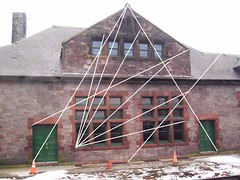regulating lines
one of the nice things about taking the train down to new york city from vermont is the turnaround that happens in palmer, mass. no one gets on or off at the train station, but you go past it twice as the train reverses direction. i've always liked this building. it's got something going on that most buildings don't. what makes it so appealing, i've wondered? this time, i happened to be re-reading a book called the old way of seeing by jonathan hale. much of the book talks about regulating lines and the innate ability of human beings to detect patterns, especially human-scaled patterns. hale argues that what makes buildings likable and interesting are the hidden and sometimes sacred geometries that regulate their design. in most buildings these lines don't exist. with this in mind, i drew some lines over the palmer station and found it singing with regulating lines. a regulating line is a line that can be drawn across a facade that connects at least three important points. the points can be corners of openings, center points or edges. as you can see in the picture there are lots of lines that connect the windows and doors. nearly every point of the facade connects with other important parts of the facade. the overall composition fits within a triangle anchored by the two doors and the peak of the gable. now, try this exercise on your average suburban home or commercial building. you'll find the lines tend to connect nothing creating a kind of blankness, void, absence. according to hale, the trend away from ordered composition began in 1830, when the symbolism of architectural elements became more important than their placement. eventually the notion of ordering a facade with geometry fell from the vocabulary of the common builder and the common world became a less beautiful place.



0 Comments:
Post a Comment
<< Home